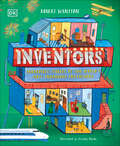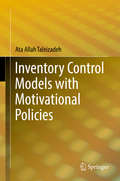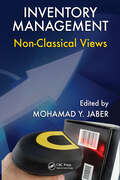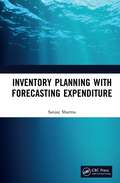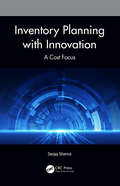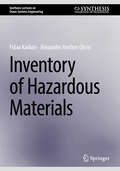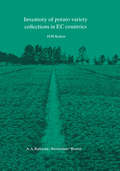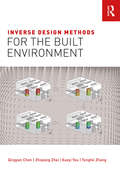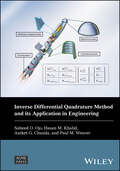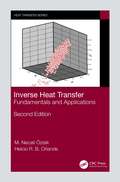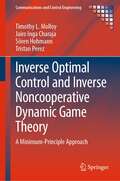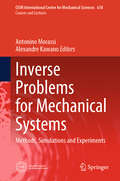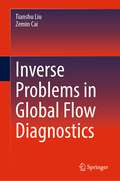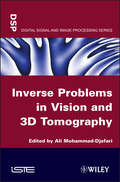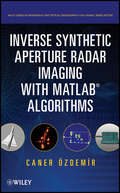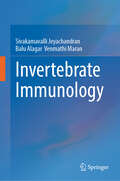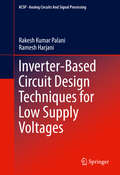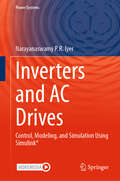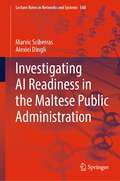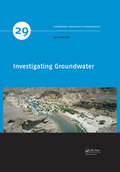- Table View
- List View
Inventors: Incredible stories of the world's most ingenious inventions (DK Explorers)
by Robert WinstonMeet the masterminds behind the greatest inventions in history with this nonfiction book for kids aged 7 to 9.Step into Leonardo da Vinci's workshop, relax on board Hideo Shima's speedy bullet train, and join movie star Hedy Lamarr to bounce ideas around in between takes. Inventors looks at the towering achievements of more than 50 inventors in great detail. The stories are as unusual as they are unique. From Mr. Kellogg, who accidentally created cornflakes after leaving grains boiling for too long, to the ancient Turkish polymath Ismail al-Jazari, who decided the best way to power a clock was with a model elephant, to Sarah E. Goode's fold-up bed space-saving solution–the inventors of this book have all used tons of creativity to find ways to improve our world. These groundbreaking inventions include the very earliest discoveries to modern-day breakthroughs in science, food, transportation, technology, toys, and more.Each page is packed with jaw-dropping facts, with every inventors' achievements written as a story. Beautiful illustrations by Jessamy Hawke bring the inventor's stories to life, and fantastic photography highlights the detail of their designs. With incredible hand-painted cross-sections revealing the intricacies of a robotic arm, the first plane, and the printing press, young readers will marvel at being able to see close-up how these amazing machines work. The inventors come from all walks of life and parts of the world, making this the perfect book for every budding inventor.
Inventory Control Models with Motivational Policies
by Ata Allah TaleizadehThis book examines the different motivational policies used for inventory management. In many competitive markets, sellers use motivational policies to encourage the customers to buy more and these kinds of strategies are used as competitive tools. This book brings together all the motivational policies for lot sizing decisions and offers a useful guide for inventory control. Each chapter applies deterministic inventory models such as economic order quantity (EOQ) and economic production quantity (EPQ), but also stochastic models for the motivational policy covered. The book begins exploring quantity discounts such as all-unit and incremental discounts. It then looks at delayed payment or trade credit policies that are applied by many suppliers and/or wholesalers to increase their sales. The motivational policies covered in the following chapters are dedicated to advance payment/prepayment schemes and also special sales offered by retailers to increase sales levels or decrease the inventory level. Finally the book concludes with a review of announced price increases, which persuades customers to buy a product at the current price, rather than paying more for it in the future. Inventory Control Models with Motivational Policies should be useful for professionals working on supply chains, but also researchers in operations research and inventory management.
Inventory Management: Non-Classical Views
by Mohamad Y. JaberAs markets become more dynamic and competitive, companies must reconsider how they view inventory and make changes to their production and inventory systems. They must begin to think outside the classical box and develop a new paradigm of inventory management. Exploring the trend away from classical models based on economic order quantities to depe
Inventory Planning with Forecasting Expenditure
by Sanjay SharmaIn industrial or business cases, purchasing and procurement are significant functions. Usually, a procurement plan is prepared based on certain predictions of consumption patterns or demand. When this plan is implemented, the benefit is obtained corresponding to forecast accuracy. In the available literature, forecasting accuracy is frequently discussed. A need is established to link forecasting accuracy with forecasting expenditures. After an explicit inclusion of the forecasting expenditure, this book describes inventory planning for procurement and production. FEATURES Discusses forecasting expenditure in detail Provides an analysis of reduction and increase in forecasting expenditures Highlights advanced concepts that include procurement inventory, production planning, and priority planning in detail Examines an approach in relation to the inclusion of an explicit cost of forecasting Covers total cost formulation, modified total cost, relevant index, threshold value, and cost of forecasting in a comprehensive manner with the help of examples Inventory Planning with Forecasting Expenditure is useful for undergraduate and postgraduate students in engineering and management and has potential for elective and supplementary core courses.
Inventory Planning with Innovation: A Cost Focus
by Sanjay SharmaInventory Planning with Innovation: A Cost Focus discusses inventory planning concepts with major emphasis on innovation to reduce cost in a single volume. Provides an understanding of innovation efforts and linking it with inventory planning in reducing cost. Offers various factors influencing innovation efforts, knowledge of investment or expenditure that might be estimated before starting the innovation efforts, purchase inventory, and the manufacturing inventory. Covers important concepts including innovation efforts, strategic period, procurement inventory, total cost estimation, production inventory, related total cost planning, multiple products, multiple items procurements, and multiple items manufacture. This reference is primarily written for senior undergraduate, graduate students, and professionals in the field of industrial engineering, production engineering, and manufacturing science.
Inventory of Hazardous Materials (Synthesis Lectures on Ocean Systems Engineering)
by Alexander Arnfinn Olsen Fidaa KarkoriThis book provides a comprehensive guide to the Inventory of Hazardous Materials (IHM), a critical document for ensuring the safe and environmentally sound recycling of ships. At the heart of this book is the matter of compliance with the Hong Kong International Convention for the Safe and Environmentally Sound Recycling of Ships, which mandates the development and maintenance of an IHM throughout a vessel's lifecycle.The chapters cover topics such as the development, review, and verification of the initial Inventory for new construction vessels, as well as the maintenance and verification processes for vessels in service. Readers will find contributions by renowned experts in marine quality welding, non-destructive testing, radiographic inspection, ultrasonic inspection, and phased array inspection. The authors provide an expert analysis of these techniques through practical case studies and theoretical perspectives.This book is an essential resource for offshore installation managers, senior safety management professionals, academics, and students in industrial design and engineering. It offers invaluable insights into regulatory compliance and best practices in ship recycling. Whether you are a seasoned professional or a student entering the field, this guide will equip you with the knowledge needed to navigate the complexities of hazardous materials management in maritime contexts.
Inventory of Potato Variety Collections in EEC Countries
by H. W. KehoeThis book gives details of collections of potato varieties in European Community (EC) countries, in alphabetical order and shows the health status of each variety. It also gives details of the location of blight and potato cyst eelworm differential sets.
Inverse Design Methods for the Built Environment
by Tengfei Zhang Qingyan Chen Zhiqiang Zhai Xueyi YouThe inverse design approach is new to the built environment research and design community, though it has been used in other industries including automobile and airplane design. This book, from some of the pioneers of inverse design applications in the built environment, introduces the basic principles of inverse design and the specific techniques that can be applied to built environment systems. The authors' inverse design concept uses the desired enclosed environment as the design objective and inversely determines the systems required to achieve the objective. The book discusses a number of backward and forward methods for inverse design. Backward methods, such as the quasi-reversibility method, the pseudo-reversibility method, and the regularized inverse matrix method, can be used to identify contaminant sources in an enclosed environment. However, these methods cannot be used to inversely design a desired indoor environment. Forward methods, such as the computational-fluid-dynamics (CFD)-based genetic algorithm (GA) method, the CFD-based adjoint method, the CFD-based artificial neural network (ANN) method, and the CFD-based proper orthogonal decomposition (POD) method, show the promise in the inverse design of airflow and heat transfer in an enclosed environment. The book describes the fundamentals of the methods for beginners, provides exciting design examples for the reader to duplicate, discusses the pros and cons of each design method and points out the knowledge gaps for further development.
Inverse Differential Quadrature Method and its Application in Engineering (Wiley-ASME Press Series)
by Saheed O. Ojo Hasan M. Khalid Aniket G. Chanda Paul M. WeaverInverse Differential Quadrature Method and its Application in Engineering Authoritative reference introducing iDQM as a numerical tool to accurately perform high fidelity analyses efficiently for solving problems in engineering governed by higher-order ordinary and partial differential equations. Inverse Differential Quadrature Method and its Application in Engineering is the first book to comprehensively cover the development of a new numerical solution technique: the inverse differential quadrature method (iDQM), as an indirect approximation technique that can circumvent numerical differentiation-induced errors in the solution of systems of higher-order differential equations. The book’s introduction highlights the historical development of numerical methods in the field while emphasising the significance of strong-form solution methods. Detailed derivations of iDQM formulations in one- and two-dimensions, approximation procedures, and error quantification are described. The subsequent chapters describe the application of iDQM to many fields of engineering including structures, heat flow, fluids, waves and multiphysics problems. Example applications covering linear and nonlinear systems are demonstrated with simple and detailed discretisation steps to aid reader understanding of iDQM. MATLAB codes for many of the illustrative examples in the book are provided to ease implementation and practice for readers. Written by a team of highly qualified academics, Inverse Differential Quadrature Method and its Application in Engineering discusses topics including: High fidelity linear and non-linear structural analyses of variable-stiffness curved beams, arbitrary-shaped plates, and cylindrical and spherical shells governed by unified formulation kinematicsiDQM error formulation and its effect on spectral convergenceAccurate and efficient solutions of non-structural problems governed by, for example, Korteweg-de Vries (KdV) wave, Helmholtz, convection-diffusion and steady state heat conduction equations and nonlinear one- and two-dimensional scalar combustion modelsStrategies to alleviate mathematical ill-conditioning of system matrices employing novel preconditioning techniques Inverse Differential Quadrature Method and its Application in Engineering is an essential reference for researchers and engineers performing advanced numerical analysis across a range of applications in the mechanical, aerospace, chemical, and civil engineering industries, along with graduate students in related programs of study.
Inverse Engineering Handbook (Handbook Series for Mechanical Engineering)
by Keith A. WoodburyInverse problems have been the focus of a growing number of research efforts over the last 40 years-and rightly so. The ability to determine a "cause" from an observed "effect" is a powerful one. Researchers now have at their disposal a variety of techniques for solving inverse problems, techniques that go well beyond those useful for relatively si
Inverse Heat Conduction: Ill-Posed Problems
by James V. Beck Hamidreza Najafi Keith A. Woodbury Filippo de MonteInverse Heat Conduction A comprehensive reference on the field of inverse heat conduction problems (IHCPs), now including advanced topics, numerous practical examples, and downloadable MATLAB codes. The First Edition of the classic book Inverse Heat Conduction: III-Posed Problems, published in 1985, has been used as one of the primary references for researchers and professionals working on IHCPs due to its comprehensive scope and dedication to the topic. The Second Edition of the book is a largely revised version of the First Edition with several all-new chapters and significant enhancement of the previous material. Over the past 30 years, the authors of this Second Edition have collaborated on research projects that form the basis for this book, which can serve as an effective textbook for graduate students and as a reliable reference book for professionals. Examples and problems throughout the text reinforce concepts presented. The Second Edition continues emphasis from the First Edition on linear heat conduction problems with revised presentation of Stolz, Function Specification, and Tikhonov Regularization methods, and expands coverage to include Conjugate Gradient Methods and the Singular Value Decomposition method. The Filter Matrix concept is explained and embraced throughout the presentation and allows any of these solution techniques to be represented in a simple explicit linear form. Two direct approaches suitable for non-linear problems, the Adjoint Method and Kalman Filtering, are presented, as well as an adaptation of the Filter Matrix approach applicable to non-linear heat conduction problems. In the Second Edition of Inverse Heat Conduction: III-Posed Problems, readers will find: A comprehensive literature review of IHCP applications in various fields of engineering Exact solutions to several fundamental problems for direct heat conduction problems, the concept of the computational analytical solution, and approximate solution methods for discrete time steps using superposition of exact solutions which form the basis for the IHCP solutions in the text IHCP solution methods and comparison of many of these approaches through a common suite of test problems Filter matrix form of IHCP solution methods and discussion of using filter-form Tikhonov regularization for solving complex IHCPs in multi-layer domain with temperature-dependent material properties Methods and criteria for selection of the optimal degree of regularization in solution of IHCPs Application of the filter concept for solving two-dimensional transient IHCP problems with multiple unknown heat fluxes Estimating the heat transfer coefficient, h, for lumped capacitance body and bodies with temperature gradients Bias in temperature measurements in the IHCP and correcting for temperature measurement bias Inverse Heat Conduction is a must-have resource on the topic for mechanical, aerospace, chemical, biomedical, or metallurgical engineers who are active in the design and analysis of thermal systems within the fields of manufacturing, aerospace, medical, defense, and instrumentation, as well as researchers in the areas of thermal science and computational heat transfer.
Inverse Heat Transfer: Fundamentals and Applications
by Helcio R.B. OrlandeThis book introduces the fundamental concepts of inverse heat transfer solutions and their application for solving problems in convective, conductive, radiative, and multi-physics problems. Inverse Heat Transfer: Fundamentals and Applications, Second Edition includes techniques within the Bayesian framework of statistics for solution of inverse problems. By modernizing the classic work of the late Professor M. Necat Ozisik and adding new examples and problems, this new edition provides a powerful tool for instructors, researchers, and graduate students studying thermal-fluid systems and heat transfer. FEATURES Introduces the fundamental concepts of inverse heat transfer Presents in systematic fashion the basic steps of powerful inverse solution techniques Develops inverse techniques of parameter estimation, function estimation, and state estimation Applies these inverse techniques to the solution of practical inverse heat transfer problems Shows inverse techniques for conduction, convection, radiation, and multi-physics phenomena Helcio R. B. Orlande is a Professor of Mechanical Engineering at the Federal University of Rio de Janeiro (UFRJ), where he was the Department Head from 2006 to 2007.
Inverse Optimal Control and Inverse Noncooperative Dynamic Game Theory: A Minimum-Principle Approach (Communications and Control Engineering)
by Timothy L. Molloy Sören Hohmann Tristan Perez Jairo Inga CharajaThis book presents a novel unified treatment of inverse problems in optimal control and noncooperative dynamic game theory. It provides readers with fundamental tools for the development of practical algorithms to solve inverse problems in control, robotics, biology, and economics. The treatment involves the application of Pontryagin's minimum principle to a variety of inverse problems and proposes algorithms founded on the elegance of dynamic optimization theory. There is a balanced emphasis between fundamental theoretical questions and practical matters. The text begins by providing an introduction and background to its topics. It then discusses discrete-time and continuous-time inverse optimal control. The focus moves on to differential and dynamic games and the book is completed by consideration of relevant applications. The algorithms and theoretical results developed in Inverse Optimal Control and Inverse Noncooperative Dynamic Game Theory provide new insights into information requirements for solving inverse problems, including the structure, quantity, and types of state and control data. These insights have significant practical consequences in the design of technologies seeking to exploit inverse techniques such as collaborative robots, driver-assistance technologies, and autonomous systems. The book will therefore be of interest to researchers, engineers, and postgraduate students in several disciplines within the area of control and robotics.
Inverse Problems for Mechanical Systems: Methods, Simulations and Experiments (CISM International Centre for Mechanical Sciences #618)
by Antonino Morassi Alexandre KawanoThis book explores the crucial role of inverse problems across various fields of applied science and technology. By examining physical phenomena governed by mathematical physics, it addresses the challenge of determining unknown parameters and developing non-destructive methods for systems of solid and structural mechanics. It delves into the inherent mathematical complexities of inverse problems and presents innovative strategies for overcoming these issues. Aimed at doctoral students and researchers in civil and mechanical engineering, mathematical physics, and applied mathematics, the book provides a solid theoretical foundation and equips readers with the necessary mathematical and computational tools to tackle diverse inverse problems.
Inverse Problems in Global Flow Diagnostics
by Tianshu Liu Zemin CaiThis book describes unified image-based measurement methods (theories, numerical methods, and algorithms) to determine the important physical quantities of complex flows in engineering and natural systems, including velocity, pressure, temperature, heat transfer, and skin friction. It presents a systematical study of the inverse problems in global flow diagnostics in a unified framework of the variational formulations. The authors further illustrate the main physical quantities in fluid mechanics, including velocity, pressure, skin friction and surface heat flux, extracted from flow visualization images obtained in experiments and observations. The developed methods are applicable in various image-based flow measurements in diverse disciplines ranging from fluid mechanics/aerodynamics to plenary sciences.
Inverse Problems in Vision and 3D Tomography
by Ali Mohammad-DjafariThe concept of an inverse problem is a familiar one to most scientists and engineers, particularly in the field of signal and image processing, imaging systems (medical, geophysical, industrial non-destructive testing, etc.) and computer vision. In imaging systems, the aim is not just to estimate unobserved images, but also their geometric characteristics from observed quantities that are linked to these unobserved quantities through the forward problem. This book focuses on imagery and vision problems that can be clearly written in terms of an inverse problem where an estimate for the image and its geometrical attributes (contours and regions) is sought. The chapters of this book use a consistent methodology to examine inverse problems such as: noise removal; restoration by deconvolution; 2D or 3D reconstruction in X-ray, tomography or microwave imaging; reconstruction of the surface of a 3D object using X-ray tomography or making use of its shading; reconstruction of the surface of a 3D landscape based on several satellite photos; super-resolution; motion estimation in a sequence of images; separation of several images mixed using instruments with different sensitivities or transfer functions; and more.
Inverse Synthetic Aperture Radar Imaging With MATLAB Algorithms
by Caner OzdemirThis book provides a full representation of Inverse Synthetic Aperture Radar (ISAR) imagery, which is a popular and important radar signal processing tool. The book covers all possible aspects of ISAR imaging. The book offers a fair amount of signal processing techniques and radar basics before introducing the inverse problem of ISAR and the forward problem of Synthetic Aperture Radar (SAR). Important concepts of SAR such as resolution, pulse compression and image formation are given together with associated MATLAB codes.After providing the fundamentals for ISAR imaging, the book gives the detailed imaging procedures for ISAR imaging with associated MATLAB functions and codes. To enhance the image quality in ISAR imaging, several imaging tricks and fine-tuning procedures such as zero-padding and windowing are also presented. Finally, various real applications of ISAR imagery, like imaging the antenna-platform scattering, are given in a separate chapter. For all these algorithms, MATLAB codes and figures are included. The final chapter considers advanced concepts and trends in ISAR imaging.
Inverse Synthetic Aperture Radar Imaging With MATLAB Algorithms (Wiley Series in Microwave and Optical Engineering)
by Caner OzdemirBuild your knowledge of SAR/ISAR imaging with this comprehensive and insightful resource The newly revised Second Edition of Inverse Synthetic Aperture Radar Imaging with MATLAB Algorithms covers in greater detail the fundamental and advanced topics necessary for a complete understanding of inverse synthetic aperture radar (ISAR) imaging and its concepts. Distinguished author and academician, Caner Özdemir, describes the practical aspects of ISAR imaging and presents illustrative examples of the radar signal processing algorithms used for ISAR imaging. The topics in each chapter are supplemented with MATLAB codes to assist readers in better understanding each of the principles discussed within the book. This new edition incudes discussions of the most up-to-date topics to arise in the field of ISAR imaging and ISAR hardware design. The book provides a comprehensive analysis of advanced techniques like Fourier-based radar imaging algorithms, and motion compensation techniques along with radar fundamentals for readers new to the subject. The author covers a wide variety of topics, including: Radar fundamentals, including concepts like radar cross section, maximum detectable range, frequency modulated continuous wave, and doppler frequency and pulsed radar The theoretical and practical aspects of signal processing algorithms used in ISAR imaging The numeric implementation of all necessary algorithms in MATLAB ISAR hardware, emerging topics on SAR/ISAR focusing algorithms such as bistatic ISAR imaging, polarimetric ISAR imaging, and near-field ISAR imaging, Applications of SAR/ISAR imaging techniques to other radar imaging problems such as thru-the-wall radar imaging and ground-penetrating radar imaging Perfect for graduate students in the fields of electrical and electronics engineering, electromagnetism, imaging radar, and physics, Inverse Synthetic Aperture Radar Imaging With MATLAB Algorithms also belongs on the bookshelves of practicing researchers in the related areas looking for a useful resource to assist them in their day-to-day professional work.
Inversion and Data Assimilation in Remote Sensing: Estimation of Geophysical Parameters (ISTE Consignment)
by Yajing YanRemote sensing data are now the primary sources for observing Earth and the Universe. Data inversion and assimilation techniques are the main tools for estimating and predicting the geophysical parameters that characterize the evolution of our planet and the Universe, using remote sensing data. Inversion and Data Assimilation in Remote Sensing explores recent advances in the inversion and assimilation of remote sensing data. It presents traditional and current neural network methods, as well as a number of topics where these methods have been developed or adapted to suit the specific nature of the field. The assimilation section covers prediction problems in volcanology and glaciology. Lastly, the inversion section covers biomass inversion using SAR images, bio-physio-hydrological inversion in coastal areas using multi- and hyperspectral images, and astrophysical inversion using telescope data.
Invertebrate Immunology
by Balu Alagar Venmathi Maran Sivakamavalli JeyachandranThis book offers a comprehensive exploration of advanced molecular techniques used to study invertebrate innate immune reactions, focusing on both humoral and cellular-mediated responses. It delves into the intricate host-pathogen interactions and the surveillance mechanisms within hemocytes, providing a detailed understanding of invertebrate immunity. The chapters cover a range of topics, including cellular and humoral immunity, with detailed discussions on the microscopic examination of hemocytes and the roles of granulocytes, agranulocytes, and semigranulocytes. The book also examines the molecular-level interactions between host and pathogen, proteomic changes, and the structural-functional relationships of immune molecules. Critical attention is given to the impact of climate change on invertebrate immunity and its applications in aquaculture and the blue economy. The inclusion of flow charts, protocols, and vivid images enhances the reader's curiosity and understanding of how these immune reactions can be studied using advanced molecular biology techniques. This book is an indispensable resource for immunologists, evolutionary biologists, and biotechnology professionals. It provides both foundational knowledge and cutting-edge research on invertebrate immunity, making it a must-read for anyone interested in the evolutionary origins and practical applications of innate immune systems. Researchers in the fields of immunology, evolutionary biology, and biotechnology will find this book particularly valuable, as it offers insights into the development of new therapeutics and the potential for invertebrate models in human studies.
Inverter-Based Circuit Design Techniques for Low Supply Voltages
by Ramesh Harjani Rakesh Kumar PalaniThis book describes intuitive analog design approaches using digital inverters, providing filter architectures and circuit techniques enabling high performance analog circuit design. The authors provide process, supply voltage and temperature (PVT) variation-tolerant design techniques for inverter based circuits. They also discuss various analog design techniques for lower technology nodes and lower power supply, which can be used for designing high performance systems-on-chip.
Inverters and AC Drives: Control, Modeling, and Simulation Using Simulink (Power Systems)
by Narayanaswamy P.R. IyerSuccessful development of power electronic converters and converter-fed electric drives involves system modeling, analyzing the output voltage, current, electromagnetic torque, and machine speed, and making necessary design changes before hardware implementation. Inverters and AC Drives: Control, Modeling, and Simulation Using Simulink offers readers Simulink models for single, multi-triangle carrier, selective harmonic elimination, and space vector PWM techniques for three-phase two-level, multi-level (including modular multi-level), Z-source, Quasi Z-source, switched inductor, switched capacitor and diode assisted extended boost inverters, six-step inverter-fed permanent magnet synchronous motor (PMSM), brushless DC motor (BLDCM) and induction motor (IM) drives, vector-controlled PMSM, IM drives, direct torque-controlled inverter-fed IM drives, and fuzzy logic controlled converter-fed AC drives with several examples and case studies. Appendices in the book include source codes for all relevant models, model projects, and answers to selected model projects from all chapters. This textbook will be a valuable resource for upper-level undergraduate and graduate students in electrical and electronics engineering, power electronics, and AC drives. It is also a hands-on reference for practicing engineers and researchers in these areas.
Investigating AI Readiness in the Maltese Public Administration (Lecture Notes in Networks and Systems #568)
by Alexiei Dingli Marvic SciberrasThe book presents a unique study on the Artificial Intelligence (AI) readiness of public administrations focusing on the Maltese public administration as a case study. This was conducted following the launch of the Malta AI National Strategy in 2019. Since the Maltese public administration is the driving force behind the integration of AI solutions nationwide, the research is deemed necessary to understand whether the public workforce itself is ready to face the oncoming AI revolution. The researchers applied a mixed-methods approach to gain insight and a broader perspective of the status quo concerning AI adoption. Important considerations that stem from this study include the need for increased AI knowledge among public administrators since the majority of respondents reported a lack of awareness of AI technologies and their deployment. Understanding AI-related advantages must be accompanied by a robust instructional effort at all levels of education. It was unanimously agreed that the early inclusion of AI-related courses in the Maltese educational system will aid in developing a future AI-savvy workforce. Furthermore, upskilling and reskilling the public officers will facilitate knowledgeable human capital and proficiencies required to effectively integrate AI solutions within society. The study concludes by recommending several critical reforms within governments that will improve the AI-readiness factor of any Public Administration.
Investigating Groundwater (IAH - International Contributions to Hydrogeology #29)
by Ian AcworthInvestigating Groundwater provides an integrated approach to the challenges associated with locating groundwater. Uniquely, the book provides a review of the wide range of techniques that can be deployed to investigate this important resource. Many of the practical examples given are based upon Australian experience but the methods have worldwide applicability. The book is published in colour and includes many original diagrams and photographs. Particular effort has been made to provide consistent terminology and SI units are used throughout the text. <P><P>Investigating Groundwater starts with an introduction to the historical significance of groundwater and gives an account of climate change. A description of the occurrence of groundwater in different rock types is then provided. A detailed account of surface water techniques is then followed by an account of the interconnections between surface water and groundwater. Four chapters describing groundwater hydraulics are then followed by four chapters describing the latest geophysical techniques. Once the best location of a borehole is determined using these techniques; chapters then describe appropriate drilling methods to use; provide a wide ranging review of geophysical logging, hydrochemical and isotopic techniques, before concluding with a detailed description of groundwater flow to a well. <P><P>Written for a worldwide audience of degree level geology/engineering practitioners, academics and students involved in groundwater resource investigation methods; Investigating Groundwater is essential reading for those involved in groundwater research. <P><P>Key Features: <li>Presents the theoretical background and a detailed description of the techniques used in the investigation of groundwater. <li>Describes the general occurrence of groundwater in different rock types; surface water hydrology and interconnected surface and groundwater systems. <li>Provides detailed descriptions of geophysical techniques (seismic, electrical, gravity and heat) and an account of available geophysical logging methods. <li>Reviews hydrochemical and isotope methods, followed by an account of drilling techniques. <li>Gives a detailed account of radial flow to a well, including appropriate modelling and pump-testing techniques and a consideration of non-linear flow. <P><P>Of interest to anyone involved in the development of groundwater resources, either for domestic supply, for agriculture or for mining.
Investigating Human Error: Incidents, Accidents, and Complex Systems, Second Edition
by Barry StrauchIn this book the author applies contemporary error theory to the needs of investigators and of anyone attempting to understand why someone made a critical error, how that error led to an incident or accident, and how to prevent such errors in the future. Students and investigators of human error will gain an appreciation of the literature on error, with numerous references to both scientific research and investigative reports in a wide variety of applications, from airplane accidents, to bus accidents, to bonfire disasters. Based on the author's extensive experience as an accident investigator and instructor of both aircraft accident investigation techniques and human factors psychology, it reviews recent human factors literature, summarizes major transportation accidents, and shows how to investigate the types of errors that typically occur in high risk industries. It presents a model of human error causation influenced largely by James Reason and Neville Moray, and relates it to error investigations with step-by-step guidelines for data collection and analysis that investigators can readily apply as needed. This second edition of Investigating Human Error has been brought up to date throughout, with pertinent recent accidents and safety literature integrated. It features new material on fatigue, distraction (eg mobile phone and texting) and medication use. It also now explores the topics of corporate culture, safety culture and safety management systems. Additionally the second edition considers the effects of the reduction in the number of major accidents on investigation quality, the consequences of social changes on transportation safety (such as drinking and driving, cell phone use, etc), the contemporary role of accident investigation, and the effects of the prosecution of those involved in accidents.
